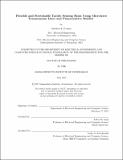Flexible and stretchable tactile sensing skins using microwave transmission lines and piezoresistive rubber
Author(s)
D'Asaro, Matthew E. (Matthew Eric)
DownloadFull printable version (45.76Mb)
Other Contributors
Massachusetts Institute of Technology. Department of Electrical Engineering and Computer Science.
Advisor
Jerey H. Lang.
Terms of use
Metadata
Show full item recordAbstract
In the related fields of prosthetics and robotics there is a need for an inexpensive, durable, wide-area, flexible stretchable skin-like material that can sense pressure and shear. While there exists a variety of tactile skins with impressive sensitivity, resolution, and integration, they are complex, expensive to fabricate, and delicate. This thesis explores two distinct technologies for creating a sensing skin based on molded PDMS silicone rubber. The first, which serves as a baseline technology for this thesis, consists of arrays of sensors made of insulating PDMS, conducting metal doped PDMS, and piezoresistive carbon black doped PDMS. Flexible and stretchable sensors capable of sensing pressure, shear, and finger angle were demonstrated. The finger angle sensor showed a sensitivity of greater than 2.3 k[omega] per degree with a 230 k[omega] resting resistance and the pressure sensor showed a sensitivity of 253 [omega] per kPa with a resting resistance of 97 k[omega]. However, the sensors showed hysteresis, poor repeatability, and had a slow response time due to the CB/PDMS material having a 200 s time constant. They also required a minimum of 2[square root]N wires at the edges of a rectangular array of N sensors. The second technology, which is novel for tactile skins, is a distributed sensor based on buried microwave transmission lines. Applied pressure deforms the silicone rubber dielectric, creating an impedance discontinuity that is used to determine the location and degree of deformation. Using an algorithm derived in this thesis, the sensor deformation can be reconstructed from S-parameter measurements across frequency. The advantages of this sensor include that it requires only one electrical connection (and ground), it is rugged, simple, and inexpensive to make, the response time is ultimately limited only by the mechanics of the sensor materials, and the sensor is easy to model. These sensors showed pressure sensitivity of at least 10 kPa, depression sensitivity of less than 20 [mu]m, and 1-D spacial sampling of 7.3 mm. They are 1.6 mm thick, 13 mm wide, and 200 mm long with the thickness and usable length of the sensor limited by the conductivity of stretchable conductors. In addition, a proof-of-concept shear sensor based on two parallel transmission lines was demonstrated.
Description
Thesis: Ph. D., Massachusetts Institute of Technology, Department of Electrical Engineering and Computer Science, 2017. This electronic version was submitted by the student author. The certified thesis is available in the Institute Archives and Special Collections. Cataloged from student-submitted PDF version of thesis. Includes bibliographical references (pages 225-232).
Date issued
2017Department
Massachusetts Institute of Technology. Department of Electrical Engineering and Computer SciencePublisher
Massachusetts Institute of Technology
Keywords
Electrical Engineering and Computer Science.